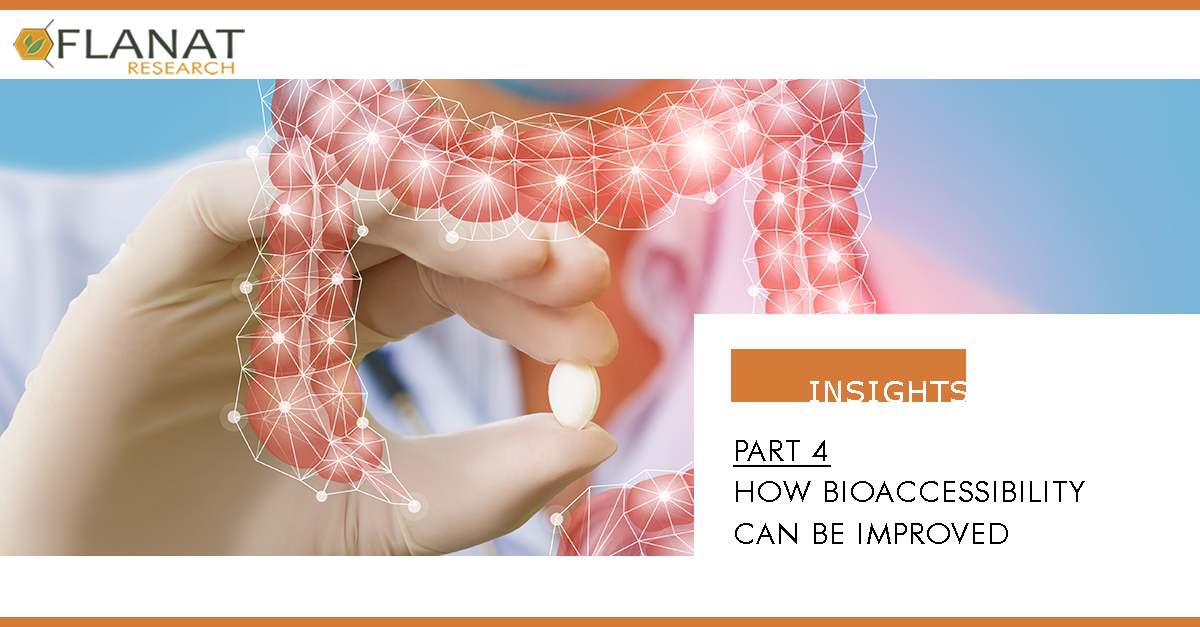As seen in the previous parts, the study of oral bioaccessibility of nutrients is fundamental in order to evaluate their bioavailability. Many phytochemicals, despite the clear effects demonstrated in vitro, could have limited health benefits because they need to be effectively transported to target tissues and organs at effective dose levels in order to have beneficial effects on health. The various physical and chemical characteristics of phytochemicals can in fact cause problems for the effective formulation of an ingredient, polyphenols are a perfect example of this. A perfect example in this case is curcumin in which the low solubility in water leads to poor bioaccessibility which therefore limits its beneficial effects. (Chen L. et al. 2006)
Over the years, there has been a growing interest in the study of bioavailability, and consequently of the possible mechanisms to improve it, and among all the strategies the encapsulation of the active ingredient in a carrier (preferably of natural origin), capable of stabilizing it and improving its bioaccessibility has also been among all the most exploited.
The purpose of encapsulation of an active ingredient is indeed its protection, but it is also to easily allow its release into the enteric tract responsible for absorption. The encapsulated actives therefore obtain better stability and bioavailability.
Among the most important parameters to consider for encapsulating an active or a phytochemical we have the nature of the carrier, the loading capacity, the encapsulation efficiency, the mechanism and the percentage of release from the carrier.
The nature of the carrier is one of the fundamental parameters for creating a good product. Due to their chemical-physical nature they can be divided into protein carriers (gelatin, wheat gluten, soy proteins, casein, keratin, collagen etc.), lipid carriers (oils and waxes, fatty acids and monoglycerides etc.) and polysaccharides carrier (cellulose, chitin, alginates, pectin etc.). Each of these ingredients can be used alone or in combination, but all these elements can potentially also be found in a phytocomplex which can then itself encapsulate phytochemicals. (Frosi I. et al. 2022)
Understanding the base on which the carrier is formulated is important to understand its functionality:
Protein-based carrier
Vegetable proteins are widely used for the development of carriers, especially given their high nutritional value, as well as their low toxicity, biocompatibility, biodegradability and numerous functions capable of producing and stabilizing emulsions and gels. The presence of different functional groups on the different amino acids that make up proteins offer a high capacity to form bonds and furthermore the amphiphilic nature of proteins makes them suitable as emulsifiers and gelling agents. Several studies have also reported that these properties can be modulated through simple technological modifications. (Chen L. et al. 2006)
If proteins are used to create microparticles, they are able to control the release of the incorporated active for correct delivery to the absorption site. This occurs by formulating the carrier in order to obtain a precise structure which can consist of a core containing the active ingredient and other ingredients and the external barrier of variable thickness.
Plant proteins can also be modified or incorporated into other materials to increase their encapsulation functionality and therefore further increase the bioaccessibility of encapsulated actives.
Lipid-based carrier
Just like proteins, lipids can also be an excellent material for encapsulating active ingredients, solid lipid nanoparticles have shown excellent delivery efficiency of lipophilic active ingredients. Vegetable lipids and oils have been much studied for their application as carriers in different encapsulation methods such as liposomes, proliposomes, phytosomes, emulsions and nanostructured lipid particles. Lipid-based encapsulation showed excellent protective, controlled and site-specific release properties.
Lipids are molecules very suitable for being modified to improve their versatility of use, also different types of lipids can be combined together to obtain different products. Examples are the phytosome and the liposome. The phytosome differs from the classical liposome for the encapsulation of the active compound based on the interaction with the hydrophilic heads of the phospholipid through hydrogen bonds. This in fact leads to the formation of a phospholipid phyto-complex in which the lipophilic phosphatidyl group envelops the choline-active compound complex, forming a more stable and efficient vesicle than the classic bilayer vesicle of the liposome. In this way the phytosome manages to implement the bioaccessibility of both fat-soluble and water-soluble compounds, even simultaneously. (Subramanian P. et al. 2021)
Polysaccharide-based carrier
Natural polysaccharides are a class of biopolymers that differ from each other in the monosaccharide units, the molecular weight and the glycosidic bonds between the monomers present in the polysaccharide chain. They are very stable, safe, non-toxic, hydrophilic and biodegradable molecules. Furthermore, thanks to the various functional groups present in the structure, they are excellent carriers for the encapsulation of phytochemicals of various nature. In fact, polysaccharides can be modeled and modified with simple technological approaches and therefore adapted to the encapsulation and delivery of active molecules.
An example of a polysaccharide widely used in this field is chitosan, a natural polysaccharide with good solubility and biodegradability which has been studied for the delivery of polyphenolic molecules. Chitosan nanoparticles can effectively achieve controlled release and increased bioaccessibility of polyphenols.
The first preparations of polysaccharide nanoparticles required the use of covalent cross-linkers such as di- and tri-carboxylic acids (tartaric, citric, malic acid for example) which allowed the condensation reaction between the carboxyl groups of the acids and the amino group terminal of the polysaccharide, allowing to obtain biodegradable chitosan nanoparticles. To date, these nanoparticles are obtained by ionic cross-linking which allows for milder and simpler preparation conditions. In fact, for charged polysaccharides, polyanions and polycations can act as ionic cross-linkers to create polyanionic and polycationic polysaccharides respectively. (Liu Z. et al. 2008)
Last but not least, in PART 5: PHYTOCLEW® - FLANAT’s polysaccharide sustainable carrier to improve bioaccessibility.

